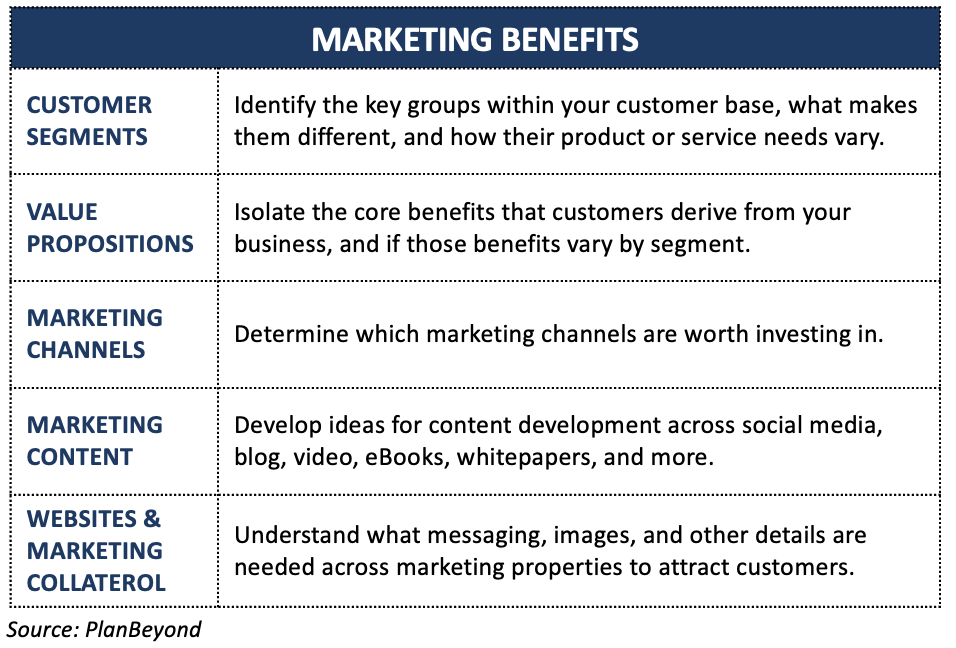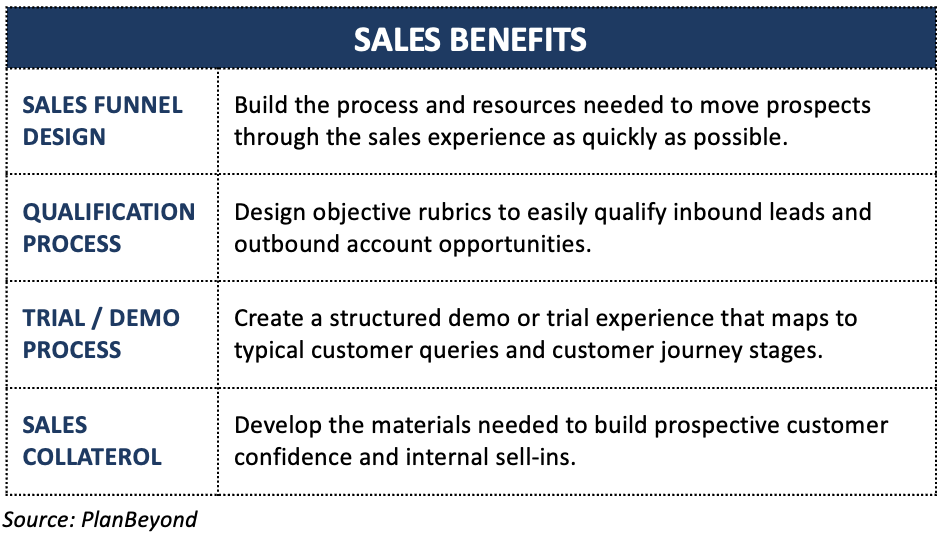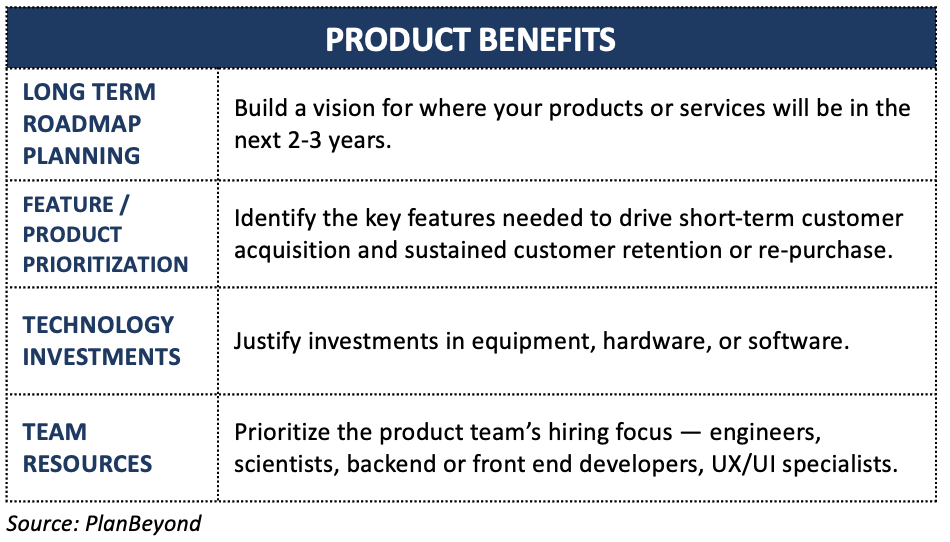Investing in market research is not a novelty project. It represents time, financial resources, and personnel bandwidth commitments.
Which begs the question: What business value can you get from doing market research in the first place?
The quick answer: A lot!
Using research to drive business strategy across key revenue centers like marketing, sales, and product means using data-driven approaches to ground your processes and decision-making. Rather than using whims, you get to use objective data. This clarifies the right path forward and rallies internal team member support, all while decreasing the chances of major business failures.
Using Research To Drive Business Strategy Across Functional Areas
Research can impact a seemingly infinite number of areas. In fact, we’ve used it to help companies with everything from content marketing ideation to visualizing ideal team structures.
Nevertheless, some of the most common ways businesses use research is to inform revenue-driving functional areas. Let’s look at three of these areas—marketing, sales, product—to see how research drives them forward.
Market Research & Marketing Strategy
Marketing is one of the most frequent areas informed by research work. Because it drives awareness and new customers, marketing often gets research allocations.
- Customer Segments: Products and services are often valuable to a variety of customers. Use market research to understand who the segments are, what drives their product or service needs, and what sets them apart. This sets the foundation for future marketing strategy and go-to-market work.
- Value Propositions: Your marketing messaging needs to resonate strongly with prospects to drive interest. Otherwise, they’ll go elsewhere. Use research to evaluate the product benefits and value propositions that get customers excited to buy. This informs messaging strategy throughout future marketing work.
- Marketing Channels: Do you know where to invest your marketing dollars? Market research can pinpoint the events, conferences, publications, newsletters, and other places your customers go to learn about their field. Use research to identify these places so that you put your money in the right channels.
- Marketing Content: Content marketing is an efficient way to build awareness and drive new customers to your business. But, it only works if the content is compelling. Market research lets you uncover what’s driving customer questions about their field, the category, or future trends. Use these learnings to fuel a content marketing engine.
- Websites & Marketing Collateral: Websites and other high-level marketing collateral are often the first place customers go to learn about a product or service. Use market research to identify the messages, imagery, and product details customers care about. Then, layer this into website and collateral development to really drive customer interest.


Market Research & Sales Strategy
Sales doesn’t always get priority when it comes to using research to drive business strategy. That’s shortsighted! Efficient, effective sales processes and operations mean faster conversions and more time spent on the right prospective customers.
- Sales Funnel Design: A good sales process defines the key stages prospects must go through to effectively close a sale. It also identifies resources needed at each step to support sales operations. Ask customers about what was good and bad about the sales process to inform the overall funnel design.
- Qualification Process: You want to spend the right time on the right customers. Building qualification protocols helps quickly identify and segment inbound leads while ensuring outbound activities are targeted to the right types of accounts. Use market research to identify the key elements that make for good customers. You can then built an effective qualification process.
- Trial / Demo Experience: Many products, especially in the digital space, lend themselves to trials or product demos. Ask customers about their evaluation criteria. This leads to building trial or demo experiences that effectively tie back to what customers are looking for.
- Sales Collateral:Â You want to have the right materials on-hand when you need it. Learn more about the resources customers use to evaluate your product, competitor products, or even products in other categories. This surfaces what sales collateral you’ll need to stay competitive.
Market Research & Product Strategy
Lastly, let’s take a look at just a few of the areas where market research informs strong product development strategy.
- Product Roadmap:Â Set the long term vision for the products or services you’ll offer. This can mean a vision for entering a new market, penetrating an existing market, or expanding into new customer or functional areas. Ask customers where they see their business headed in 2-3 years. Then, make sure your roadmap aligns to that.
- Feature / Product Prioritization:Â Shorter term, you’ll need to prioritize product development. This could be new features, new SKU’s, or any other unit of “newness” in your industry. Customer research shows you what should make the cut, and what shouldn’t.
- Technology Investments: Given the items above, you may need new equipment, hardware, or software. These are major expenses. With research data in-hand, you now have a way to justify the expense.
- Team Hiring: You can’t reach your short-term product goals or long term roadmap needs without the right team. As the research illustrates where to head, you’ll identify who you need to make it happen. This could be engineers, scientists, developers, UX/UI specialists, or possibly more niche specialists depending on your business category.

[stm_spacing lg_spacing=”20″ md_spacing=”20″ sm_spacing=”20″ xs_spacing=”5″]
How Much Can You Learn In One Research Project
The good news is that you can learn a great deal from just one research project. Whether that project is based in customer interviews or surveys, a single project lends itself to several learning objectives. Nevertheless, you do need to home in on the core strategic area of interest.
For instance, perhaps strategic direction is most needed in marketing. Use one research project to address most, if not all, of the marketing strategy areas listed above. Additionally, tack on one other learning objective from the Product or Sales category. You’ll drive significant learnings for Marketing while another team benefits as well.
With structured research designs, businesses get ample “bang for their buck” out of research to inform a wide host of strategic areas. The key is establishing learning objectives at the project onset. This ensures that the research output answers your full breadth of business questions.






